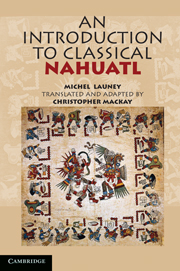How to Use This Book
Published online by Cambridge University Press: 05 June 2012
Summary
The thirty-six lessons are divided into two parts. The sixteen that comprise the first part cover the most basic elements of the language, and at the end of this section, there is an extensive set of review exercises to help make sure that you are in full command of the fundamental elements of the language before proceeding to the finer points dealt with in the second part. Each lesson also has a large number of exercises. These are very thorough in the earlier lessons, with a particular emphasis on acquiring an active knowledge of the forms. Experience shows that students have an aversion to translating from English into the language being learned. Naturally, it is more difficult to produce the forms rather than simply converting the Nahuatl sentences into English, but it is the very act of manipulating the language through active composition that allows you to understand the forms and their uses. A key to the exercises is provided in Appendix Four, but you are strongly advised to avoid using it until you have finished all the exercises and have done your best to find the solution to something you are having trouble with in the lesson (many fine points in the exercises can be figured out this way). Each lesson comes with a list of vocabulary items at the end, and these should be memorized. Those who have learned all these words should have a very good basic vocabulary at their fingertips when they go on to reading texts. The English-Nahuatl vocabulary at the end of the book is a full listing of all the words in the vocabularies of the individual lessons, but the Nahuatl-English is limited to words useful for completing the English-Nahuatl exercises.
- Type
- Chapter
- Information
- An Introduction to Classical Nahuatl , pp. xix - xxPublisher: Cambridge University PressPrint publication year: 2011

